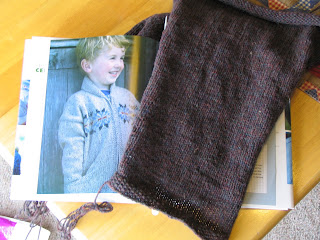Today is my last day for Project FeederWatch. The Cornell Lab of Ornithology sponsors this project which is a "survey of feeder birds during winter." People from all over the U.S. and Canada participate in this project. Since this was the first winter in a long time when I knew I wasn't going to have to work on the weekends, I decided to try it again.

Bluejay selects a peanut from the window feeder -- this feeder is only out in the winter.
The nice thing is that you can do the whole project on-line if you have internet access (there's also a mail-in option for people who don't have a home computer). My first weekend began November 11-12, 2006. We had received 10.5" of snow just the day before, so there were lots of birds at my feeders that weekend.
The more acrobatic bluejays can choose a peanut from the wreath feeder hanging in the tree.
The numbers of birds fluctuated throughout the season and I was amazed at the numbers and variety of birds appearing in my yard when I actually took the time to sit and watch them. Some of the more notable results were 13 cardinals seen in February, a northern shrike that appeared one weekend in November, a white-breasted nuthatch that visited me until the 23rd of January (I'm guessing Cooper's Hawk got him), and the rare winter visitor -- a clay-colored sparrow that was at my feeders from the middle of January to the middle of February.

Male house finch enjoys a bath in the heated bird spa.
It's been a fun season and I would encourage anyone who watches the birds at their feeder to participate. The Cornell Lab of Ornithology tabulates this data to determine increases or declines in the songbird populations and if weather or some other factor contributes to these trends. There is a small cost ($15) to participate, but I think it was worth it for what I found out about birds in my yard. It will be interesting to see how things change next year.

Plain suet out now to discourage starlings. The woodpeckers love this tree because the bark is really rough and they spend lots of time pecking around behind the loose pieces of bark.
To participate or find out more information, go to www.feederwatch.org


 The bunny even showed up to try and find some corn for munching. It's sort of unusual to see the bunny out in the middle of the day and so close to the house. They're usually hiding out somewhere until later in the afternoon and into the evening. I saw this big bunny come hopping out from under the brush pile.
The bunny even showed up to try and find some corn for munching. It's sort of unusual to see the bunny out in the middle of the day and so close to the house. They're usually hiding out somewhere until later in the afternoon and into the evening. I saw this big bunny come hopping out from under the brush pile.



































 During the winter of 2005, they started cutting the trees down, and cut, and cut, and cut, until there was nothing left by spring. Then they moved the house and shed away, and most of last summer was spent grading out all of the grass and bringing in truckloads of fill so they could establish the site for the truck dealership. Of course it had to be huge because they have bunches of those big semi tractors and also a huge showroom/office/shop building where all the other work has to be done.
During the winter of 2005, they started cutting the trees down, and cut, and cut, and cut, until there was nothing left by spring. Then they moved the house and shed away, and most of last summer was spent grading out all of the grass and bringing in truckloads of fill so they could establish the site for the truck dealership. Of course it had to be huge because they have bunches of those big semi tractors and also a huge showroom/office/shop building where all the other work has to be done.












